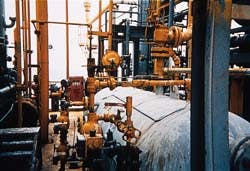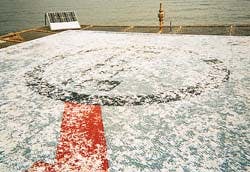TECHNOLOGY Electronic sound system rids platforms of seagulls
Maintenance costs for cleaning and repainting this production equipment have increased because of paint deterioration from seagull droppings (Fig. 1).
Seagull droppings coat a helipad, making the surface dirty and slippery (Fig. 2).
An electronic sound system, which uses recordings of seagulls in distress, has effectively rid several Gulf of Mexico platforms of problem-causing seagulls.
The unwanted birds and their droppings cause messy, dangerous, and unhealthy conditions and increase the expense for repairs and cleaning, according to Louisiana Land & Exploration Co., which has had problems with the birds on some of its 43 platforms in the Gulf (Figs. 1 and 2).
Excretion from the sea gulls is highly acidic and deteriorates protective paint on the platforms, said Doyle Savell, measurement supervisor for LL&E in Lafayette, La. Savell said LL&E must sandblast and repaint its platforms about every 3 years. LL&E needed an effective method of ridding the platforms of seagulls to help extend the life of the paint on the platforms.
LL&E tried using owl decoys, a natural enemy of seagulls, to frighten away the birds but had little success, said Savell. The seagulls pushed the decoys out of the way and resumed roosting on the platforms. In another approach, LL&E played tapes of gun shots and explosions. The loud sounds scared the birds away for only a week or two until the birds became familiar with the noises and then returned to roost.
Bird repeller
LL&E then tried a device which replicates and broadcasts authentic seagull distress cries with high fidelity through four speakers installed on the platform. The device, called the Super BirdXPeller, operates automatically and covers up to 10 acres without harm to the environment, according to manufacturer Bird-X Inc. in Chicago. The equipment consists of a small box with electronics wired to several solid-state speakers which can be permanently powered by solar panels connected to batteries.
LL&E tested the device for 75 days on a quiet, 60 ft 3 70 ft nonproducing platform-a favorite haunt of the seagulls. Before installing the electronic repeller, LL&E cleaned up the entire platform, which consisted of three decks and a helipad.
According to Savell, the sound system with the sea gull distress cries kept the birds away. LL&E performed fly-by visual checks three times a week and landed on the helipad once a week and found no droppings on the platform. The repeller was completely effective for more than 3 months, so LL&E installed the system with solar panels on two other platforms frequented by seagulls.
The Super BirdXPeller, the solar panels, the batteries, and installation cost about $1,200 for a platform, according to LL&E.
Extending the life of a paint job by 1 year, even for a small platform, can save an operator thousands of dollars in maintenance expenses, said Savell. He expects this electronic repeller to help extend the life of the paint on the platforms by 2-3 years. LL&E also expects to save money by the reduced need for steam cleaning the platforms several times per year, which can run about $500 per man on each job, depending on the severity of the mess.
Another benefit comes from the healthier environment for platform workers because the bird droppings can harbor harmful bacteria.
Amerada Hess Corp., Houston, has had similar problems with seagull droppings on its offshore platforms. Amerada Hess also had little success with owl decoys and other methods of frightening the birds, said Larry D. Barker, superintendent.
Barker said the bird droppings ruin paint and make surfaces extremely slick and dirty. The droppings detract from the appearance of the platforms and raise a safety issue if the helipad is unclean and slippery.
Barker is experimenting with a Super BirdXPeller at Amerada Hess' West Cameron 576 site, an 80 ft 3 90 ft platform with two decks and a helipad. Since installing the system, Amerada Hess has seen very few seagulls around the platform and no droppings on it.
Copyright 1996 Oil & Gas Journal. All Rights Reserved.

